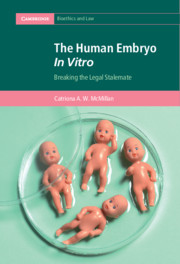Book contents
- The Human Embryo In Vitro
- Cambridge Bioethics and Law
- The Human Embryo In Vitro
- Copyright page
- Dedication
- Contents
- Foreword
- Acknowledgements
- Table of Cases
- Table of Legislation
- Abbreviations
- Introduction
- Part I Into Liminality
- Part II Through Liminality
- Part III Out of Liminality
- 6 A Context-Based Approach
- 7 Looking Forward
- Conclusion
- Bibliography
- Index
Conclusion
from Part III - Out of Liminality
Published online by Cambridge University Press: 18 March 2021
- The Human Embryo In Vitro
- Cambridge Bioethics and Law
- The Human Embryo In Vitro
- Copyright page
- Dedication
- Contents
- Foreword
- Acknowledgements
- Table of Cases
- Table of Legislation
- Abbreviations
- Introduction
- Part I Into Liminality
- Part II Through Liminality
- Part III Out of Liminality
- 6 A Context-Based Approach
- 7 Looking Forward
- Conclusion
- Bibliography
- Index
Summary
This book, concerned with the regulation of human embryos in vitro, and their use for reproduction and research, has explored the ways in which law does, and can regulate processually. As we have seen, the 1990 Act is static and unchanging with respect to the moral status of ‘the embryo’, yet our societal understandings and perceptions of embryos are not. The 1990 Act is, as we have seen, permanently liminal. A ‘gothic’ framing of embryos and the use of a liminal lens have each revealed a key facet of embryo regulation. All of the practices that law currently allows are regulating for: uncertainty, process, and change. Here, the truism coined by Thomassen that ‘liminality is’ has been explored and unpacked with reference what this means for embryos that are subject to our legal architecture. The reality of liminality still has much to say about the way we regulate in vitro embryos. This book has provided the reader with ways to think about the ways we navigate law, and processes governed by law into, through and out of liminality in ways that bring greater insights into the sensitive enterprise of regulating for uncertainty, when our focus of attention is an entity as fluid and remarkable as the human embryo.
- Type
- Chapter
- Information
- The Human Embryo In VitroBreaking the Legal Stalemate, pp. 206 - 207Publisher: Cambridge University PressPrint publication year: 2021

